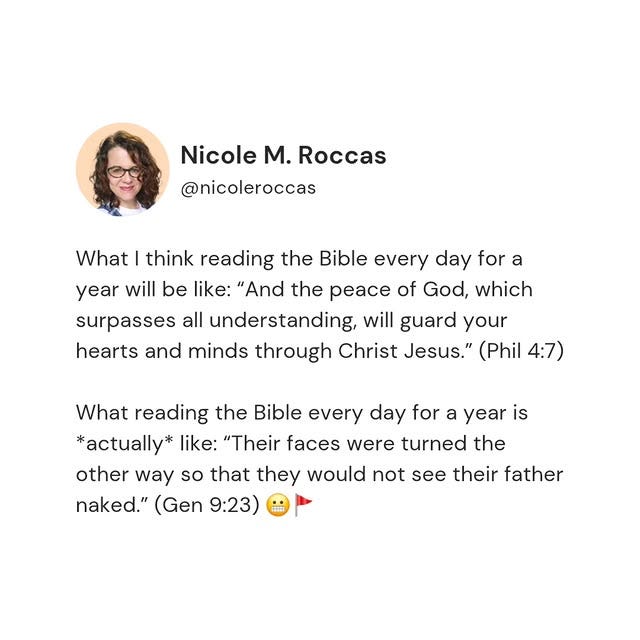(In the second half of this post, I share what Bible and other tools I use for Scripture reading.)
» Don’t forget! This winter, I’m hosting a weekly writers meetup on Thursday mornings. Learn more and register if you’re wanting to prioritize writing this year.
I have a practice of reading the Bible every year. More accurately, I have a practice of *starting* to read the Bible every year.
I generally take my leave once the exciting and delightfully unhinged stories of Genesis give way to increasingly tedious details, place names, and laws. I’m lucky if I make it past Exodus (mid-February according to my One-Year Chronological Bible).
Which means that, as I write this, I’m a scant month away from Moses receiving the Law and endlessly supplying Israel with mind-numbing guidelines for how to build the ark, order their lives, etc. I can’t be bothered to read the instructions to save her life—or assemble even the most convoluted IKEA shelving units. I can already feel the walls of my attention span closing in around me.
The only time I’ve made it through the Old Testament was when I was required to do so for a college class I took during a single January term. Between the Old Testament itself and supplemental reading materials, there were hours of reading every day—I loved it. What I struggle with, apparently, is not reading the Old Testament itself, but doing so slowly, without putting the rest of my life on hold for it, and without the motivating factor of a bless-his-heart arthritic professor scolding me for neglecting key details and tropes on an exam.
Still, I have reason to hope that 2025 will be different.
This past October or so, for reasons unknown, I suddenly and without effort returned to a habit of daily devotional Scripture reading and study. This kind of “morning quiet time” was one of the few and best rituals I observed as a Protestant, but it was unfortunately one of the first things to fall through the cracks upon my conversion to Orthodoxy nearly 15 years ago.
It’s not that I stopped reading the Bible when I became Orthodox, but I needed to break up with the more literalist, legalistic hermeneutic I was accustomed to reading it with. And in some ways, I now “read” (with my eyes and ears) more Scripture than ever before (the Liturgy alone, the main Eucharistic service of the Orthodox Church, is an hours-long tapestry woven from the weft of some 120+ Scripture references, to say nothing of the Scripture one absorbs from other prayers, icons, services, and blessings in which one’s Orthodox life is embedded).
Yet these references are often just that—spare verses and pericopes (single narrative units), wrought together into a new creation. What one gains from the Liturgy is an experience of Scripture as a unitive, experiential, and liturgical whole, but what one sometimes loses touch with is the narrative and contextual totality each portion of scripture is situated in. The unique, and sometimes less eloquent, connective tissue that comprise each book of the Bible.
Just as a fish doesn’t know it’s in water, I don’t always apprehend the living Water that surrounds me, especially when I’m not in the habit of drawing from it for the sake of my own soul. I grow accustomed, forgetful, even heedless. For months or even years, I’ve missed the steadiness of daily practice, of letting my attention rest on the Bible in a spirit of devotion, the turn of its onion skin pages like the lapping of a warm sea.
And to be honest, even reading the Bible for teaching and writing doesn’t always feel complete. When reading for the sake of students, an audience, or a writing project, I am often doing so for specific information, or to be able to help others understand it better, or to shed light on a particular topic. It’s not the same as reading the Bible on its own terms against the backdrop of your actual, screwed up, God-blessed life and self.
So here we are, another January. Maybe there is hope for me, just as there is hope for us all. Maybe this year I’ll make it past Exodus. Maybe, like NASA’s Voyager 1’s exit from the solar system, I’ll make it out of the Torah, into that dark, exiled realm of the prophets. Or even the New Testament (don’t hold your breath, that’s not until September 24!).
In Defense of… a New Series?
Let’s say I do keep going—and I’m not making any promises. I’d like to share some regular thoughts on how it’s going, what I’m learning, and how my ADHD self is taming her inattention in the trickier passages. Maybe once or twice a month?
To the extent I manage to follow through, I’ll call this series “In Defense of…”, which each new post completing that statement with the phrase “reading the _(adj)_ parts” (of the Bible).
Here are some ideas I’m toying with, for when the inspiration strikes:
In Defense of Reading the Boring Parts
In Defense of Reading the Offensive Parts
In Defense of Reading the Familiar Parts
In Defense of Reading the Patriarchal Parts
In Defense of Reading the Apocryphal Parts
In Defense of Reading the Easy Parts
In Defense of Reading the Hard Parts
I’ve got a whole list going (the random parts, the mystical parts, the scary parts, the hard-to-pronounce parts) but I’d also love to hear your ideas! What would you like to see a post on? Hearing what sparks people’s interest and curiosity would give me some sustenance on my little journey, especially as the desert is coming!
>> What other “In Defense of…” posts would you like to see me write about? Let me know in the comments!

How I Read (or Don’t Read?) the Bible in a Year as an Orthodox Christian
The Bible I Use
For the last few years, I’ve used this edition of Tyndale’s One-Year Chronological Bible as my homebase. It’s the NLT translation, which is *absolutely not my preference* (don’t at me, all you Bible scholars!). I only use this particular edition because, along with laying out the Bible chronologically in terms of when events happened (which I find a more helpful aid to comprehension and memory for personal Bible reading), it also has wide margins suitable for making notes. (You can also find chronological reading plans out there and use them with whatever Bible you prefer.)
And anyway, my (frequent) annoyance with the NLT is actually a blessing in disguise—it spurs me to read multiple translations in conversation with one another (like the Orthodox Study Bible or Harper Collins Study Bible + Apocrypha) so I can note differences and similarities. This, I’ve found, is an excellent way to sit with some of the trickier passages.
A quick note: I’ve been blessed by my pal Traci Rhoades (), who hosts a Chronologial Bible Reading Group on Facebook group, full of 1000+ folks of different Christian traditions and backgrounds reading through the chronological Bible each year.
How to Include the Deuterocanonical Books (Apocrypha)
The One Year Chronological Bible does not contain the Apocrypha/Deuterocanonical books—you have to intercalate them on your own. (Others have created their own plans for doing this while keeping to a chronological plan, see here, or this chronological Bible with Catholic Apocrypha). Be forewarned that there are some differences between the Catholic and Orthodox apocrypha, so reading plans from Catholic sources may not include all the Deuterocanonical books recognized in the Eastern or Oriental Orthodox canons.
As I won’t get to any apocryphal books until I’m well out of the Torah, and since I usually tap out by then anyway, I haven’t yet decided what I’ll do when I get there. I may or may not choose to include them in this year’s journey.
One-Year Bibles + the Orthodox Lectionary
Why don’t I just stick to reading the Orthodox lectionary every year? Short answer: because it doesn’t include all the chapters of the Bible—not by a long shot.
More complex answer: I don’t actually find the lectionary to be a terribly helpful way to read and understand the Bible as a whole, or even specific books within it as whole units—I don’t think that’s what it was intended for. The lectionary is not an all-encompassing Bible reading plan, but a kind of greatest hits album of Scripture. It introduces us to the key narratives and instructions that were deemed most beneficial for individual and corporate edification. It marks out the general contours of the Bible for novices, and lights the way of edification for fans who want to get into the deep tracks.
The lectionary also skips around during the week, and lurches forward during the year—for example, when we move from the Sundays of Pentecost to the Feast of the Elevation of the Cross (sometimes referred to as the Lukan jump) and begin to anticipate Advent and Lent. Trying to formulate a plan where you read the whole Bible in a way that somehow also syncs with the lectionary will scramble your brain (ask me how I know). For me, I find it best to see lectionary reading and more extensive Scripture reading as two separate, albeit mutually enriching, disciplines.
Supplementary Reading and Engagement
One thing I’ve learned over my years of failed Bible reading plans is that immersing myself in Scripture more rather than less is helpful. Approaching daily readings as something I have to get through or tick off a list each morning—something I can put behind me as soon as I close the Bible—is, counter-intuitively, where boredom begins for me. Instead, finding ways throughout my day or week to increase my engagement with whatever book or passage I’m reading keeps me interested and helps demystify some of the obscurities that tend to bore me. Even though this requires spending more time in and around the very things I struggle to stay interested in, it tends to make me more rather than less interested. I like immersive environments and hyperfixations, so this should be no surprise to me.
I keep up the engagement through things like Bible crossword puzzles and trivia games, coming up with dumb tweets like this one:
I also enjoy reading or listening to books alongside the Bible to help me go deeper. I personally prefer reading from a wide range of scholars and authors, not just those from my same faith background—they make me think and open up new vistas. Currently I’m making my way through Amy-Jill Levine’s course on the Old Testament and James Y. Pennington’s thesis on Trauma Treatment Using Narrative Therapy and Theological Reflection (which centers on the story of Joseph).
Here are a few other works on my TBR:
Stephen de Young, The Whole Counsel of God: An Introduction to Your Bible (Ancient Faith: 2022) — This is a re-read for me, and I’m looking forward to it.
Tod Linafelt and Walter Brueggeman, An Introduction to the Old Testament: The Canon and Christian Imagination (2021)
Matthew J. Lynch, Flood and Fury: Old Testament Violence and the Shalom of God (2023)
» Is anyone else out there reading through the chronological Bible this year?
» What books, articles, or other resources have you found helpful for personal Bible study and reflection?
» What other “In Defense of…” posts would you like to see here?








I vote for your first suggestion "In Defense of Reading the Boring Parts" because those parts are truly boring, ie Leviticus - Deuteronomy. It is a slog to get through. Does it count as reading it if you skim?
I too am also a huge fan of the Chronological Bible. I re-started it last year and finally made it past the Torah and am now in April (lol) and now it's the story of David and I appreciate how the repeated stories across 1/2 Samuel and 1/2 Chronicles are condensed in one narrative. The most amazing thing about the chronological format is how David's psalms are interspersed throughout the narrative. Reading about him trying to escape from Saul killing him, and then reading the exact psalm he wrote in the stressful moment and his relentless trust in God is just way more inspiring and epic.
Rooting for us all to make Bible reading a consistent daily habit in our lives! Thanks for inspiring us, Nicole <3
Nicole, I love this idea. I'd like to add a suggestion of "in defense of..." for reading the whole Bible like a Complete Story. Contrasted with seeing the Bible as a collection of essays from different authors. This would be helpful as we see how our own lives (aka small story) fit into this "Larger Story." I look forward to reading your thoughts.